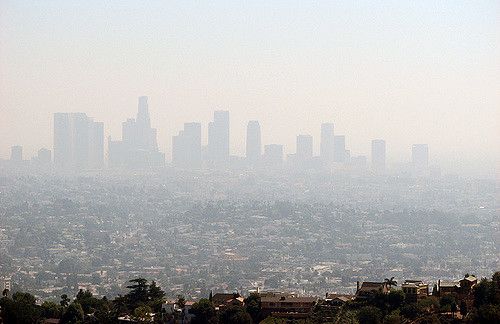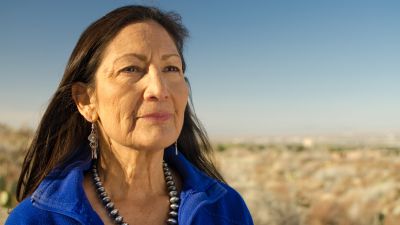
More than half of the deaths in L.A. County have come just since Thanksgiving, as the outbreak accelerates.(Photo by Ben Amstutz, Flickr CC 2.0)
Jim Hoggan has 30 years of PR experience and a passionate interest in global warming. Founder of DeSmogBlog, he’s been working for years to make the world sit up and take notice of the dangers of climate change, and to counter industry propaganda. During that time he’s found the public sphere increasingly “polluted” with toxic discourse — which led Hoggan to seek a way through the verbal smog, interviewing experts at communication from psychologists to the Dalai Lama. The result is I’m Right and You’re an Idiot: The Toxic State of Public Discourse and How to Clean It Up. Kristin Miller talked with Hoggan about the book and the state of dialogue in the public square.
Kristin Miller: Why did you get involved with climate communication?
Jim Hoggan: Back in 2005, when I started DeSmogBlog, I thought, “How is it possible that these guys, these scientists are losing a debate? They have virtually all the evidence on their side. They are seen by most people in most countries as more credible than people who are spokespersons for industry. How is it possible that they could actually be losing at debate to people who had no science on their side and people who in general if you took a close look at them you wouldn’t trust?”
KM: What did you bring as a communications professional to this puzzle?
— Jim Hoggan
JH: I don’t think we know as much about the science of science communication as we know about global warming. How you engage people on a level like this is an incredibly complex question. There’s an old saying in public relations that most people are not paying attention to most things, most of the time. What you have to struggle with is getting someone’s attention. Getting them to think something has to do with them. Because people have a finite pool of worry and you’re not able to just take on new challenges without getting rid of some old ones. So, I brought a different framework to the discussion.
KM: What’s at the core of the problem with our communication style?
JH: We keep slipping into this false idea that evidence will change people’s minds. And when you have a public square that’s so polluted with polarization and propaganda, people find the public square is becoming destabilized. There’s Trump and his Twitter and the massive amounts of information that are being thrown at people. People are just simply overwhelmed. That situation makes it difficult to even get people’s attention so you must be talking about something people care about. Polar bears are great — people care about them but they care way more about what’s happening in the local school that their kids are going to. And for good reason.
KM: Why is it so hard to change minds on climate change?
JH: It is true that one of the reasons that the public is so slow to get this proximate sense of truth around climate change is propaganda. Industry has been working so hard to tribalize the issues so that people think ‘this isn’t something that people like us think.’ So, if you do think that you must be one of ‘them.’ When you tribalize science, it’s very problematic.
And another part of it is this kind of faith in Descartes that scientists have; they believe that by providing the information will lead people to understand. I can tell you that in 1930 when the public relations industry started it was based on an understanding that facts are not enough — that emotions are an important part of adding meaning. Information doesn’t give meaning in the way that academics or scientists often think it does.
— Jim Hoggan
KM: Do scientists and advocates really have to give up facts as you say in one chapter?
JH: I have a background in law and philosophy. I believe in facts. I think evidence is really important. “If not facts, what?” You certainly want the fact because it gives structure to the conversation. They need to give up on the idea that facts are enough.
You need to be able to talk to people’s hearts and heads, not just their heads. I think that we need to have conversations about values — real conversations about things like hope and fear and mistrust and those kinds of emotional elements that are part of this emotional dialogue. We need to get better at the emotional dialogue. Emotion will beat facts almost any day.
KM: Do scientists resist changing the way the argument is framed?
JH: I think some of them struggle with it. But scientists have a responsibility here too. If you’re not doing a very good job telling your story, someone else is going to tell it for you, and you might not like it.
KM: How do you convince people on climate change without the numbers?
JH: Climate change is at heart a conversation about risk and experts have this tendency to look at descriptions of risk as a probability conversation — like a mathematical conversation. Whereas the public looks at it as who’s in control of this. Who’s getting the benefit and who’s taking the risk. They look at it through this lens of polarization and mistrust so you need to have a conversation with that state of mind and I think that is mainly an emotional conversation.
— Jim Hoggan
So, if you focus on facts too much you scare people and fear is a paralyzing emotion. You need to counter the fear with hope or anger or another kind of emotion that is a mobilizing emotion. So I can understand why a scientist might say, “Wait, whoa — you’re trying to turn me into a PR person.” But no, I wouldn’t say that; I’d say, “I’m just trying to turn you into a good communicator.” You look at somebody like the Dalai Lama or Al Gore or David Suzuki — the reason these guys get standing ovations is not because they got their facts right; it’s because they got their values right. They’re having an emotional connection with people. I don’t think most scientists should be striving to get standing ovations, but you should be striving to care what you are are talking about.
KM: You talk about a moral narrative. What do you mean by this?
JH: What’s missing is the moral narrative — the moral story. When you look at something like the pope’s encyclical, you see it. That is a moral narrative. And if you look at the research that’s been done around it when it was released in the United States, some of the tougher numbers in public opinion around climate change moved for the first time in over a decade. There were a lot of people who believed scientists were debating over whether it was a serious human-caused problem. That number started to change. Because of the encyclical a lot of people started to think climate change was more serious — big numbers like 15 percent of Catholics. A researcher at Yale even called it The Francis Effect.
Certainly, he’s the pope, so moral narrative is easier for someone who is a spiritual leader. But scientists being able to have a values conversation is really a necessary part of moving forward on science communications.
KM: Has the Trump administration’s rhetoric made things worse?
JH: I can’t believe that people are talking about fake news like it’s something new. I started seeing this fake news in 2005 when we started DeSmogBlog, and it wasn’t just fake news. It was fake science, fake scientists, fake scientific reports, fake scientific journals, fake scientific groups, fake citizen’s groups. There was this massive campaign to convince people that climate change was a hoax and that it was this liberal idea that any sensible person should just ignore or fight against. But recently, yes, that kind of polarizing or my side bias or cultural cognition — this tribalizing of science has actually become worse.
The institution of media doesn’t know what to do with demagoguery and/or authoritarianism or whatever you want to call it — that style of propaganda. It kept getting mixed up and treating it like it was just the Republican candidate when this was like pure Putin-like propaganda that was going on. The whole idea that you can counteract it by checking facts is naïve. I mean, of course you need to do that — I’m not saying facts aren’t important. But it’s not enough, because the process of polarizing is kind of fact-free in the way that he’s doing it. So he’s taken it to a level that I’m shocked by. To think that you could so blatantly just lie and people say, “Well, he’s my liar. Sorry, I still support him.”
— Jim Hoggan
KM: How do you have a conversation with someone who believes absolutely the opposite?
JH: We need to get better at finding common ground and we need to be listening. You do not want to be the cartoon that’s been created of you as a scientist or a liberal or a Democrat. When you really react, you look like you are exactly what they are accusing you of — that you’re anti-democratic. That you don’t care about their views. You’re not listening.
Try to figure out ways to step in and to be the first one. Listening is effective when you can acknowledge other people’s honestly. You need to be able to recognize that, that they may be well-intentioned and not an idiot because they disagree with you but that they may just have a different view than you do. That is a kind of golden rule way of looking at conflict.
KM: How do you keep outrage in check?
JH: The upside to DeSmogBlog and Climate Cover-Up is that it creates greater awareness of this type of propaganda and polarization, but it reinforces polarization. When you know as much as I’ve learned about bad behavior, it’s so easy to be furious. That’s the trick: to know when you are in this state of anger, how do you apply the advice on better communication? How do you deal with the deceit and corruption, and how do you put these things into practice? You can be really rightfully mad, but remember: anger is a good motivator, but a bad strategy.
KM: Are you hopeful or hopeless about our public square dialogue?
JH: Not hopeless. People know what I’m talking about with this book, because people are embroiled in conflicts and resolving conflicts like most people who are adults — even kids — every day. We know that we have to be working on communication. And the golden rule is not new; it’s right at the heart of every major religion of the world. People are used to that in the abstract — what’s new is how. This is more trying to really explore ways that you can resolve differences without just being mortal enemies.
KM: How do you recommend people go about communicating over divisive issues?
JH: Practice. You need to make it a habit. I’m not saying that people shouldn’t speak out against injustice; you just need to learn to do it in a way that doesn’t cause more hatred. It’s a skill. If somebody is telling you what they feel, you have all the opportunity in the world to have a conversation with them. But that’s where conversation and communication starts, not ends. I don’t think it’s easy. It takes more work that than most people would think, and it starts with taking the board out of our own eye before we try to take the sliver out of other people’s. If you want people to listen to you, you have to be ready to listen to them.
This is all within our ability — I don’t think there are any reasons to be despairing.



